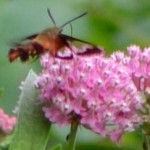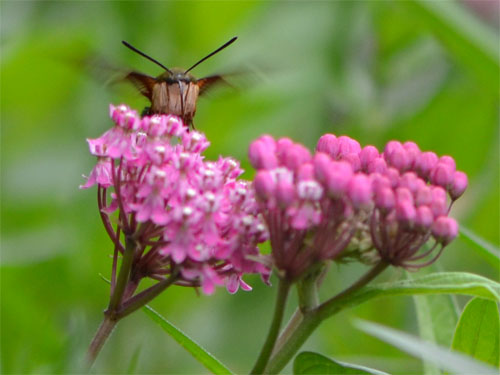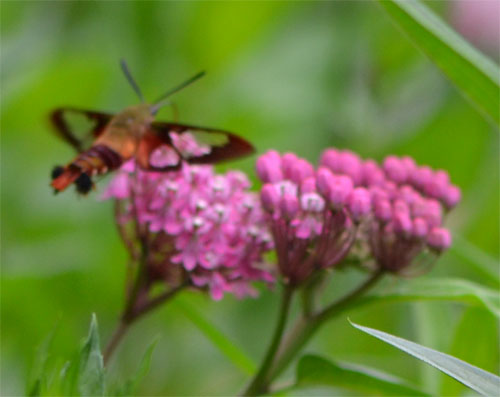 Sometimes a design is so good or successful that it is worth repeating, often over and over again. Just look at our marine mammals who have adapted over eons, in some form or another, the finlike appendages of fish. However, we are not going to be fooled easily in mistaking one for the other unless you are referring to the Miami Dolphins and their opponents’ fans who yell out “squish the fish” on fall football weekends. When you see a hummingbird moth, you will actually do a double take. My yard has been frequented around the clock by several hummingbirds for a few months now, but I just started seeing Hemaris thysbe, or common clearwing, this week. Their favorite plants to visit are the milkweeds. Since “common clearwing” is not the most descriptive of names, “hummingbird moth” has taken on a life of its own.
Sometimes a design is so good or successful that it is worth repeating, often over and over again. Just look at our marine mammals who have adapted over eons, in some form or another, the finlike appendages of fish. However, we are not going to be fooled easily in mistaking one for the other unless you are referring to the Miami Dolphins and their opponents’ fans who yell out “squish the fish” on fall football weekends. When you see a hummingbird moth, you will actually do a double take. My yard has been frequented around the clock by several hummingbirds for a few months now, but I just started seeing Hemaris thysbe, or common clearwing, this week. Their favorite plants to visit are the milkweeds. Since “common clearwing” is not the most descriptive of names, “hummingbird moth” has taken on a life of its own.
The hummingbird moth feeds on nectar of flowers (in my yard it feeds almost exclusively on milkweed). They do this in a fashion that seems to imitate a real life hummingbird: They hover with the body suspended near the head of the flower, with wings beating so fast that they seem translucent. It has other bird like features such as the beaklike probiscis that is used to collect the nectar, and it has a tail like appendage. On top of that, it makes a buzzing sound when it flies around and it has a soft downy or feathery appearance to boot! The hummingbird moth is also peculiar in that it flies in full daylight, while most other moths prefer a nocturnal existence.

When you look a little closer, though, you can see that this moth is considerably smaller than the ruby-throated hummingbird (1-1/2 inches long vs. 3 inches). it has a rather fat body that tapers at both ends. When the moth first emerges from its crysalis, its wings are covered with reddish brown scales. However, shortly thereafter, the scales fall off the central part, leaving a translucent area on each wing (thereby earning the name clearwing, I guess). The body color is variable, but they typically have an olive green back, with a wide, reddish brown band. Males usually have a tuft at the back end of the abdomen, which mimics the spread tail feathers of a hummingbird.
While the mature insect prefers milkweed nectar, the caterpillar feeds on the leaves of plants in the honeysuckle family. The animal overwinters in its cocoon among the fallen leaves, and pupates over the winter, emerging as a moth in late spring or early summer.

Although not the best picture, this clearly shows the translucent area on the wings of the common clearwing, or hummingbird moth. Cummaquid July 22 2012
So cool! Hope to see these myself soon